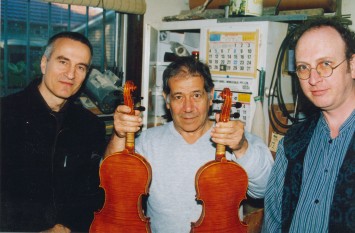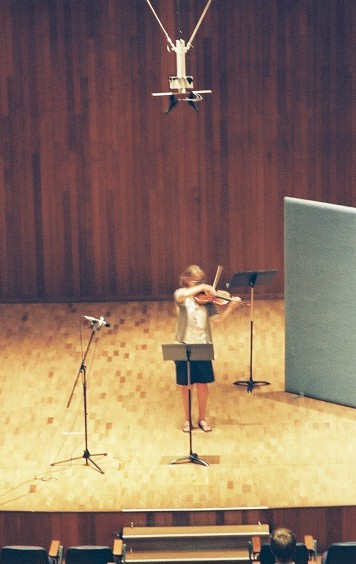| Do playing, ageing and/or environmental
changes affect violins?
Whether it is a product of the passage of time, the
exposure to the atmosphere and its variations, or the
amount of playing, many violinists believe that oldies
are goodies, and spurn inexperienced instruments. When
Michael Lea, curator of music at the Powerhouse
Museum, wanted to buy for the museum's collection
an instrument by renowned maker Harry Vatiliotis, and
when simultaneously Sydney musician Romano
Crivici commissioned an instrument from the same
maker, an opportunity arose to examine these questions.
Harry has a reputation for making fine instruments,
and for making them reproducibly. This project began
in 2001, when he made two very similar instruments from
wooden plates, seasoned for 80 years, that had originally
been intended to make a cello. Thus the bellies came
from adjacent areas of the same slab of spruce, and
both backs came from the same sample of maple.
During and after construction, they were subjected
to acoustical tests by Ra Inta, PhD student in the Acoustics
Lab at UNSW and, when finished, to playing and listening
tests. Since then, one has been maintained in controlled,
museum conditions. It is only occasionally played. Meanwhile,
the other belongs to Romano and is his usual instrument
for performance and practice.
We can imagine several ways in which age and playing
might affect violins.
- Evolution of adjustable components. Players
change various components and properties, such as
the size and style of bridge, the type of string and
the position and other properties of the sound-post.
In each case, the player is likely to reverse the
change unless it is perceived to improve the instrument.
Thus a played violin might gradually 'evolve' towards
a preferred region in its possible parameter space.
There may also be another 'selection pressure': instruments
that are unsatisfactory and that cannot be thus improved
will usually have a lower market value and be played
by less experienced players. Instruments that acquire
a better reputation and market value will in general
be sought and played by more experienced players.
These improvements will occur independently of any
change in the intrinsic mechanical properties of the
instrument.
- Age-related mechanical changes. The intrinsic
mechanical properties could change with age or with
exposure to different environments and their daily
and seasonal variations. For example, woods used in
string instruments often have a high ratio of elastic
modulus to density, and drying of wood over time would
lower the density. However, there is no simple reason
to expect that age-related changes in general would
necessarily improve an instrument.
- Playing-related mechanical changes. Components
of a violin undergo considerable low-amplitude, mechanical
vibration during playing. In principle, one could
imagine that this might alter the intrinsic mechanical
properties. There is usually a strong correlation
between the age of an instrument and the total amount
of playing it has had. Again, there is again no simple
reason to suggest that these changes will improve
the instrument. (One might however argue that mechanisms
that produce mechanical loss could be affected by
sufficiently vigorous excitation.)
It is difficult to study the effects of ageing and playing
on violins. Time is notoriously difficult to control as
a variable, particularly in the decreasing direction.
The museum offers advantages for such a study: a high
quality instrument is maintained under controlled conditions.
And museums are good at maintaining material and documents
for long periods. Hence this study.
So, how have the Powerhouse Twins diverged over time?
Three tests have now been conducted. The instruments
were compared when new, after 3 years (in 2004) and
then four days later, after the regularly played instrument,
and not the other, had been adjusted during a session
involving the owner and the maker. During this session,
new strings and bridge were fitted, and minor adjustments
were made to the soundpost.
The first good news for the study came at the first
set of trials. The panels of experienced violinists
who performed the playing and listening tests on the
new instruments gave results that showed no statistically
significant differences. Harry really can make two very
similar instruments! Another interesting result is that,
in both of the further two tests, the panels of experienced
violinists, who played the instruments blindfolded,
or who listened to them, also gave results that were
not significantly different.
The playing and listening panels were players who
had not previously played or heard these instruments.
What of someone who is very familiar with one of the
violins? (Strangers may not be able to identify identical
twins, but their parents often can.) In a separate,
blindfold, playing trial conducted after the last comparison
experiment, Romano Crivici, the owner of the played
violin, was asked to play a scale and a short piece
on the instruments as they were presented to him in
random order, and to identify each instrument by saying
"mine" or "museum's". He was correct in 20 out of 24
trials, which is significant at the 99% level. It is
not known to what extent he may have used tactile cues.
(The varnish of the regularly played instrument shows
signs of wear.)
The expert panel give the two instruments statistically
similar ratings and even Romano cannot distinguish them
with certainty. Three years of playing (and three years
of exposure to constant vs varying environmental conditions)
is not enough, it seems, to make a substantial difference.
Three years is not considered a long time for an instrument
of which there are examples still being played after
hundreds of years. The investigators hope that this
study will continue, with this pair of instruments,
for a time comparable with the age of these older violins.
More detail is available on the scientific
report to be published by Acoustics Australia in
the April 2005 edition.
|

Violinist Romano Crivici, Luthier Harry
Vatiliotis and Michael Lea,
curator of music at the Powerhouse museum, with the
newly finished
"Powerhouse Twins", in Harry's workshop, 2001.

Violinist Anthea Mulder plays one of
the twins, blindfolded, in
the Clancy Auditorium, UNSW. (Anthea waived the anonymity
accorded to subjects and allowed the use of this photo.)
 A scale played on the regularly played instrument (1.1
Mbyte).
A scale played on the regularly played instrument (1.1
Mbyte).
 A scale played on the rarely played instrument (same
player).
A scale played on the rarely played instrument (same
player).
|

